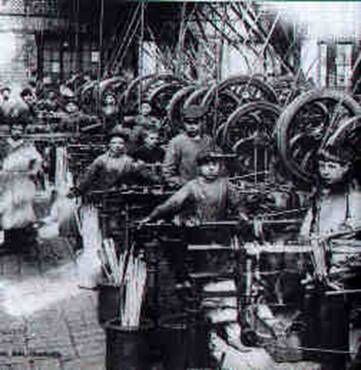Difference between revisions of "Industrial Revolution"
(replaced England with UK/Britain) |
|||
| Line 1: | Line 1: | ||
[[Image:Ind Rev.jpg|right]] | [[Image:Ind Rev.jpg|right]] | ||
| â | The '''Industrial Revolution''' refers to the change in economy from farming to manufacturing which occurred in [[ | + | The '''Industrial Revolution''' refers to the change in economy from farming to manufacturing which occurred in the [[United Kingdom]] in the late 1700s, and slowly spread to other nations, during which time machines such as the steam engine and telegraph were invented. [[Pollution]] became a problem for the first time because of the increase in factories. The UK, which at the time had the strongest economy in the world, was the first to undergo the industrial revolution, although some historians cite the iron industry in [[China]] under the Song dynasty and the textile industry in India as being forerunners to what happened in Britain {{fact}}. It is generally recognised that the industrial revolution began in 1760 in Britain and then, aided by the economic insights of [[Adam Smith]], the country's economy expanded and its industrial revolution lasted until 1840. |
| â | The industrial revolution was headed by the | + | The industrial revolution was headed by the British cotton industry. For centuries this market had been dominated by individuals; cloth would be spun and woven by hand. However, in the 1700âs advances in technology began to drive out the homemade cotton industry. Such machines Richard Arkwrightâs water frame spinning machine and Edmund Cartwrightâs power loom could make higher quality cloth and sell it for a cheaper price. Britain's cotton textile production was boosted beyond any competition. |
In the 1760âs [[James Watt]], an engineer from [[Scotland]], created an engine that was powered by steam. Though it was initially used to pump water from mines, the steam engine quickly spread to other industriesâensuring that the industrial revolution would prevail. The spread of the steam engine increased the demand for coal many times. This use of coal contributed to the iron industry. | In the 1760âs [[James Watt]], an engineer from [[Scotland]], created an engine that was powered by steam. Though it was initially used to pump water from mines, the steam engine quickly spread to other industriesâensuring that the industrial revolution would prevail. The spread of the steam engine increased the demand for coal many times. This use of coal contributed to the iron industry. | ||
Revision as of 17:58, March 4, 2008
The Industrial Revolution refers to the change in economy from farming to manufacturing which occurred in the United Kingdom in the late 1700s, and slowly spread to other nations, during which time machines such as the steam engine and telegraph were invented. Pollution became a problem for the first time because of the increase in factories. The UK, which at the time had the strongest economy in the world, was the first to undergo the industrial revolution, although some historians cite the iron industry in China under the Song dynasty and the textile industry in India as being forerunners to what happened in Britain[Citation Needed]. It is generally recognised that the industrial revolution began in 1760 in Britain and then, aided by the economic insights of Adam Smith, the country's economy expanded and its industrial revolution lasted until 1840.
The industrial revolution was headed by the British cotton industry. For centuries this market had been dominated by individuals; cloth would be spun and woven by hand. However, in the 1700âs advances in technology began to drive out the homemade cotton industry. Such machines Richard Arkwrightâs water frame spinning machine and Edmund Cartwrightâs power loom could make higher quality cloth and sell it for a cheaper price. Britain's cotton textile production was boosted beyond any competition.
In the 1760âs James Watt, an engineer from Scotland, created an engine that was powered by steam. Though it was initially used to pump water from mines, the steam engine quickly spread to other industriesâensuring that the industrial revolution would prevail. The spread of the steam engine increased the demand for coal many times. This use of coal contributed to the iron industry.
Throughout the middle ages iron was smelted using charcoal, however in the eighteenth century, new methods of iron production were discovered; the resulting iron was of higher quality than ever before. These advances, such as the process developed by Henry Cort in 1780âs, greatly encouraged the use of machinery in other industries.
The growth of industry soon brought to light the need for a better system of transportation. While canals and roads did improve, they were soon overshadowed by a means of transportation that held great promise: the railroads. The railroads may have been that most important factor of the industrial revolution. Railways had existed as early as 1500, but in 1700s the primitive wooden rails were replaced with wrought iron. These new rails enabled horses to pull even heavier loads with relative ease. But dependence on horsepower did not last for long. In 1804 the first steam-powered locomotive pulled 10 tons of ore and 70 people at 5 miles per hour. This new technology improved dramatically; locomotives reached speeds of 50 miles per hour! While the railroads revolutionized transportation, they further contributed to the growth of the industrial revolution by causing a great increase in the demand for iron and coal.
During the industrial revolution, advances in technology enabled factories to produce their goods without as many laborers. Unfortunately, this decrease in demand for workers made for terrible working conditions; factory owners could afford to only hire those willing to work the longest hours at for least pay. Child labor was common. It is this that causes many people to hail the industrial revolution as a great evil. At any rate, it did contribute to the child labor laws and minimum wage that we see today[Citation Needed].
